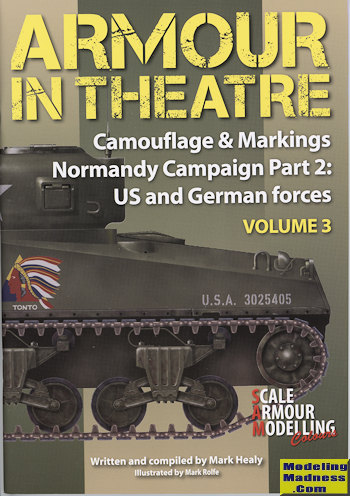 This is the
third volume of Guideline's armor camouflage and markings series, which has been
retitled 'Armour in Theater' to better represent what the series is really
covering. It is more than just great profiles and photos, but also a concise
history of campaigns that feature armor. In this particular volume, the
concentration is on US and German forces during the Normandy campaign.
This is the
third volume of Guideline's armor camouflage and markings series, which has been
retitled 'Armour in Theater' to better represent what the series is really
covering. It is more than just great profiles and photos, but also a concise
history of campaigns that feature armor. In this particular volume, the
concentration is on US and German forces during the Normandy campaign.
While most of the German armor was concentrated against the British (US forces
were never up against Tigers during the Normandy campaign), it doesn't mean
there was no armor action with the US. Indeed, while there were not that many
tanks opposing US forces, there were plenty of anti-tank guns and the US also
had to fight through the bocage. This was something for which Allied troops were
quite unprepared. The Germans were masters at defense and rather than taking
days to break out towards Paris, it took months.
New tactics had to be developed in order to deal with
this new obstacle. Fields were small and each one was grimly defended, resulting
in a high cost in men and materiel to break through it. One of the innovative
items developed by a US sergeant was the hedge cutter. These
were pieces of German beach defense steel, cut to shape and welded on the front
of Sherman and Stuart tanks. This innovation allowed US tanks to slice through
the bocage, allowing faster movement.
Eventually, Bradley was able to break out of bocage
region and with Patton in command, started a rapid advance to the west and
south. It was decided to have his army move east and meet up with the British in
order to trap the German army. This was stymied as Patton was not allowed to
move into areas assigned to the British. While this infuriated Patton, there was
little he could do. The result is that though the Germans were trapped in a
pocket, they were not surrounded and over half of the trapped troops managed to
escape before the British were able to move the 12 miles south and close the
gap. Still, even at this, it was a huge loss for the Germans who could ill
afford the destruction of equipment and capture of troops.
In line with other books in the series, this one
combines an excellent history, well chosen period photographs, superbly drawn
color profiles and a relatively in-depth look at the camouflage of the vehicles
that operated during the campaign. This one concentrates on the US side of
things and while American vehicles were all pretty uniform, the German equipment
is quite interesting. Also interesting is that it is the experience in Normandy
that developed the 'ambush' camouflage used by Germans for much of the rest of
the war.
In all, it makes for an outstanding book on the subject
that is highly readable, easy to understand and provides the sort of photos and
illustrations that simply make a read like this more enjoyable. Even if you are
not an armor builder, you'll find a lot in this one. It is a great way to combine history with camouflage information. Highly recommended.
May 2016.
My thanks to
www.guidelinepublications.co.uk for providing the review copy.
Visit your local bookstore for availability.
If you would like your product reviewed fairly and
fairly quickly, please contact
the editor or see other details in the Note to
Contributors.
 This is the
third volume of Guideline's armor camouflage and markings series, which has been
retitled 'Armour in Theater' to better represent what the series is really
covering. It is more than just great profiles and photos, but also a concise
history of campaigns that feature armor. In this particular volume, the
concentration is on US and German forces during the Normandy campaign.
This is the
third volume of Guideline's armor camouflage and markings series, which has been
retitled 'Armour in Theater' to better represent what the series is really
covering. It is more than just great profiles and photos, but also a concise
history of campaigns that feature armor. In this particular volume, the
concentration is on US and German forces during the Normandy campaign.